Analysis of Contract and Negligence in Business Law: A Report
VerifiedAdded on 2020/01/28
|12
|4569
|33
Report
AI Summary
This report delves into the crucial aspects of contract and negligence within a business context. It begins by outlining the essential elements of a valid contract, including offer and acceptance, intention to create legal relations, consideration, and the capacity of parties, with supporting case law. The report then explores different types of contracts and the impact of their terms, differentiating between express and implied terms, and the role of representations. Furthermore, it analyzes case scenarios to illustrate the application of contract principles, such as the distinction between an offer and an invitation to offer. The report also examines the consequences of classifying contract terms as conditions, warranties, or in-nominate terms. Finally, it contrasts contractual liability with tortious liability, focusing on the nature of liability in negligence and the concept of vicarious liability, supported by relevant case studies. This report provides a comprehensive overview of these critical legal concepts, offering valuable insights for students and professionals alike.
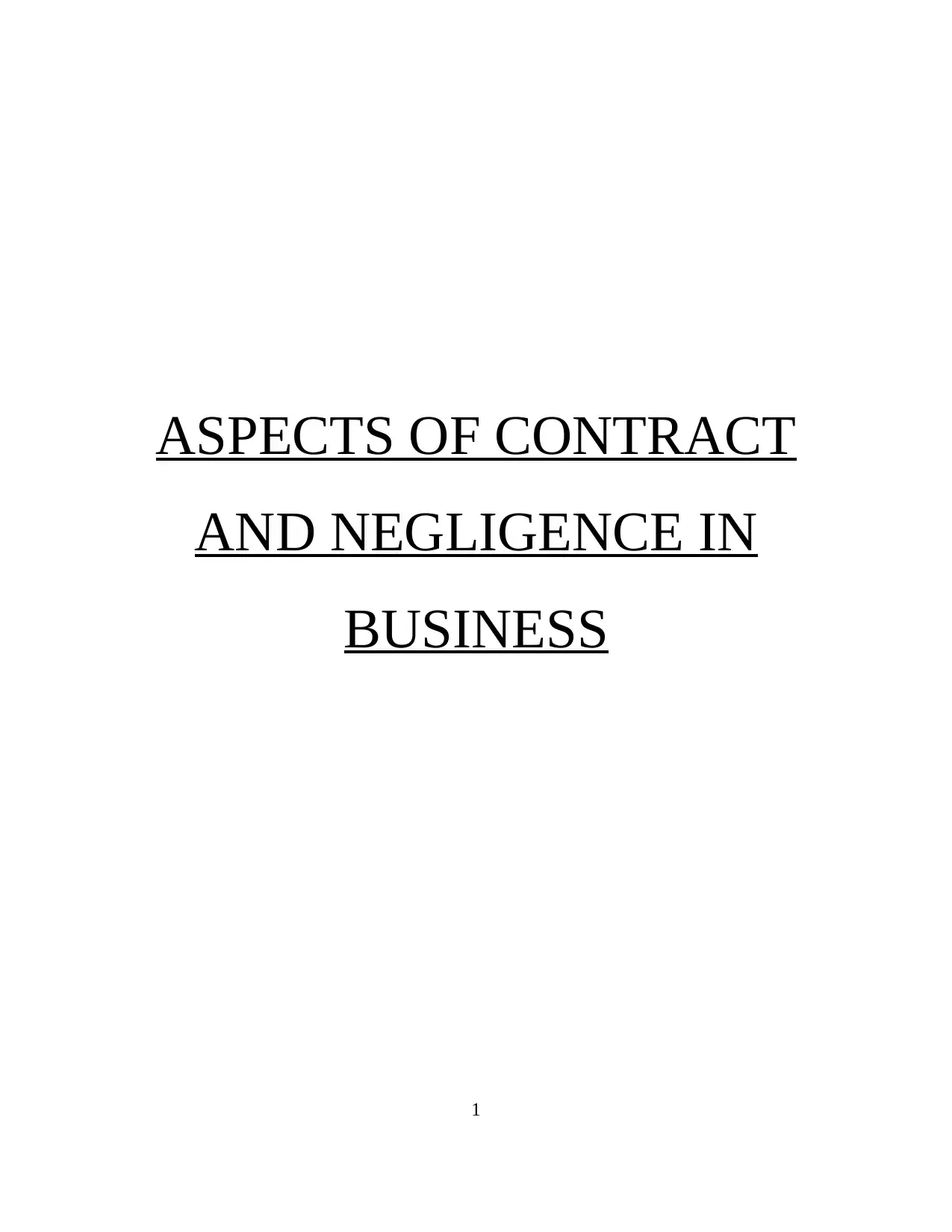
ASPECTS OF CONTRACT
AND NEGLIGENCE IN
BUSINESS
1
AND NEGLIGENCE IN
BUSINESS
1
Paraphrase This Document
Need a fresh take? Get an instant paraphrase of this document with our AI Paraphraser
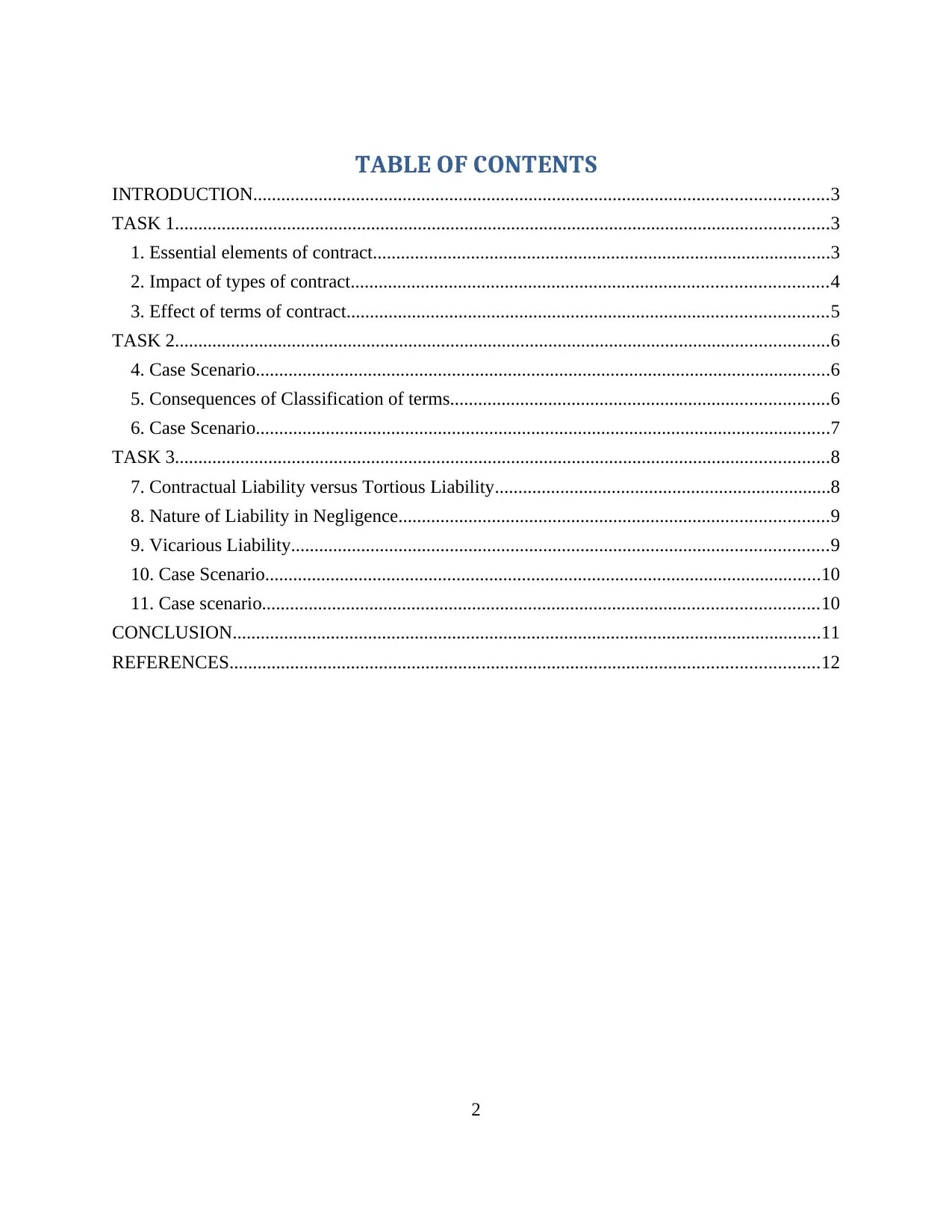
TABLE OF CONTENTS
INTRODUCTION...........................................................................................................................3
TASK 1............................................................................................................................................3
1. Essential elements of contract..................................................................................................3
2. Impact of types of contract......................................................................................................4
3. Effect of terms of contract.......................................................................................................5
TASK 2............................................................................................................................................6
4. Case Scenario...........................................................................................................................6
5. Consequences of Classification of terms.................................................................................6
6. Case Scenario...........................................................................................................................7
TASK 3............................................................................................................................................8
7. Contractual Liability versus Tortious Liability........................................................................8
8. Nature of Liability in Negligence............................................................................................9
9. Vicarious Liability...................................................................................................................9
10. Case Scenario.......................................................................................................................10
11. Case scenario.......................................................................................................................10
CONCLUSION..............................................................................................................................11
REFERENCES..............................................................................................................................12
2
INTRODUCTION...........................................................................................................................3
TASK 1............................................................................................................................................3
1. Essential elements of contract..................................................................................................3
2. Impact of types of contract......................................................................................................4
3. Effect of terms of contract.......................................................................................................5
TASK 2............................................................................................................................................6
4. Case Scenario...........................................................................................................................6
5. Consequences of Classification of terms.................................................................................6
6. Case Scenario...........................................................................................................................7
TASK 3............................................................................................................................................8
7. Contractual Liability versus Tortious Liability........................................................................8
8. Nature of Liability in Negligence............................................................................................9
9. Vicarious Liability...................................................................................................................9
10. Case Scenario.......................................................................................................................10
11. Case scenario.......................................................................................................................10
CONCLUSION..............................................................................................................................11
REFERENCES..............................................................................................................................12
2
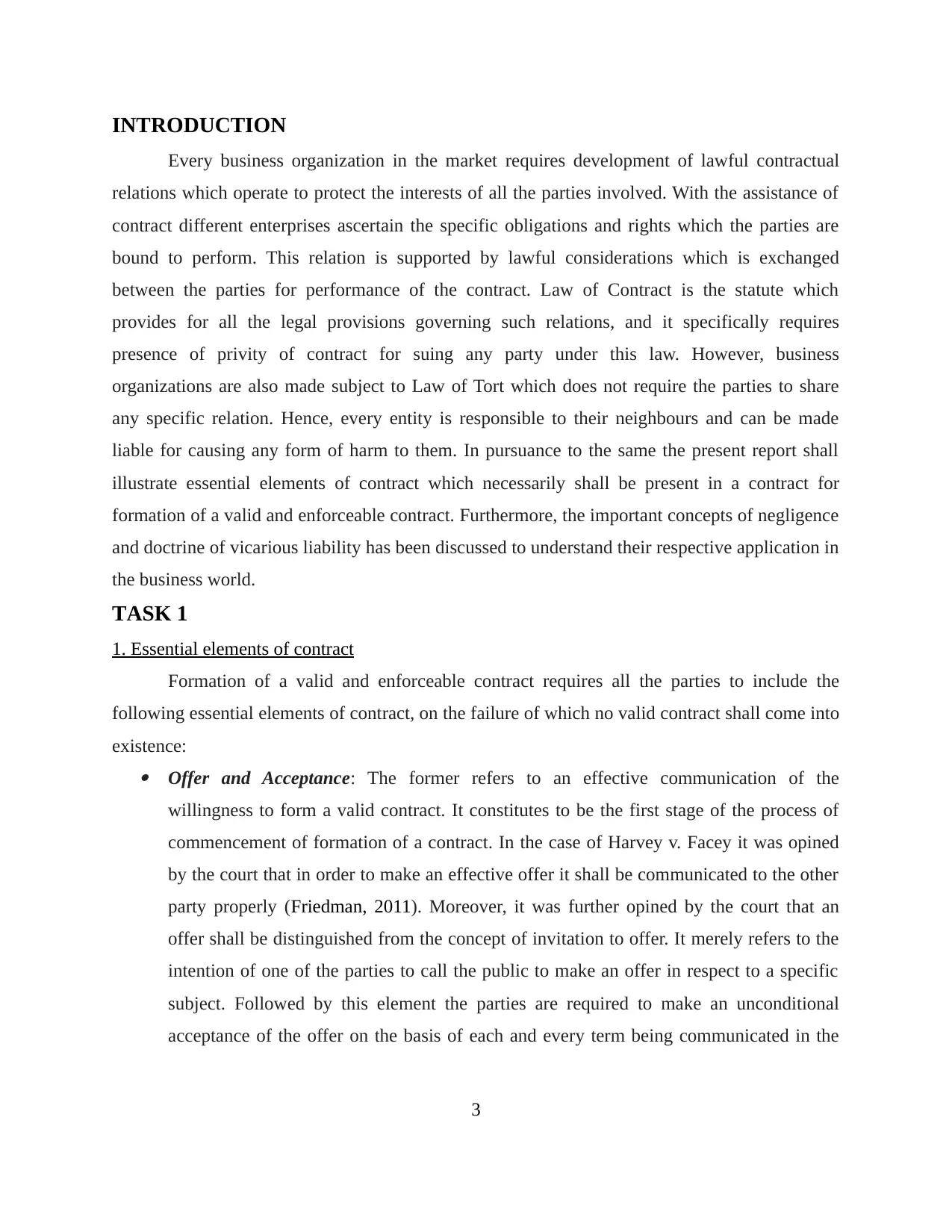
INTRODUCTION
Every business organization in the market requires development of lawful contractual
relations which operate to protect the interests of all the parties involved. With the assistance of
contract different enterprises ascertain the specific obligations and rights which the parties are
bound to perform. This relation is supported by lawful considerations which is exchanged
between the parties for performance of the contract. Law of Contract is the statute which
provides for all the legal provisions governing such relations, and it specifically requires
presence of privity of contract for suing any party under this law. However, business
organizations are also made subject to Law of Tort which does not require the parties to share
any specific relation. Hence, every entity is responsible to their neighbours and can be made
liable for causing any form of harm to them. In pursuance to the same the present report shall
illustrate essential elements of contract which necessarily shall be present in a contract for
formation of a valid and enforceable contract. Furthermore, the important concepts of negligence
and doctrine of vicarious liability has been discussed to understand their respective application in
the business world.
TASK 1
1. Essential elements of contract
Formation of a valid and enforceable contract requires all the parties to include the
following essential elements of contract, on the failure of which no valid contract shall come into
existence: Offer and Acceptance: The former refers to an effective communication of the
willingness to form a valid contract. It constitutes to be the first stage of the process of
commencement of formation of a contract. In the case of Harvey v. Facey it was opined
by the court that in order to make an effective offer it shall be communicated to the other
party properly (Friedman, 2011). Moreover, it was further opined by the court that an
offer shall be distinguished from the concept of invitation to offer. It merely refers to the
intention of one of the parties to call the public to make an offer in respect to a specific
subject. Followed by this element the parties are required to make an unconditional
acceptance of the offer on the basis of each and every term being communicated in the
3
Every business organization in the market requires development of lawful contractual
relations which operate to protect the interests of all the parties involved. With the assistance of
contract different enterprises ascertain the specific obligations and rights which the parties are
bound to perform. This relation is supported by lawful considerations which is exchanged
between the parties for performance of the contract. Law of Contract is the statute which
provides for all the legal provisions governing such relations, and it specifically requires
presence of privity of contract for suing any party under this law. However, business
organizations are also made subject to Law of Tort which does not require the parties to share
any specific relation. Hence, every entity is responsible to their neighbours and can be made
liable for causing any form of harm to them. In pursuance to the same the present report shall
illustrate essential elements of contract which necessarily shall be present in a contract for
formation of a valid and enforceable contract. Furthermore, the important concepts of negligence
and doctrine of vicarious liability has been discussed to understand their respective application in
the business world.
TASK 1
1. Essential elements of contract
Formation of a valid and enforceable contract requires all the parties to include the
following essential elements of contract, on the failure of which no valid contract shall come into
existence: Offer and Acceptance: The former refers to an effective communication of the
willingness to form a valid contract. It constitutes to be the first stage of the process of
commencement of formation of a contract. In the case of Harvey v. Facey it was opined
by the court that in order to make an effective offer it shall be communicated to the other
party properly (Friedman, 2011). Moreover, it was further opined by the court that an
offer shall be distinguished from the concept of invitation to offer. It merely refers to the
intention of one of the parties to call the public to make an offer in respect to a specific
subject. Followed by this element the parties are required to make an unconditional
acceptance of the offer on the basis of each and every term being communicated in the
3
⊘ This is a preview!⊘
Do you want full access?
Subscribe today to unlock all pages.

Trusted by 1+ million students worldwide
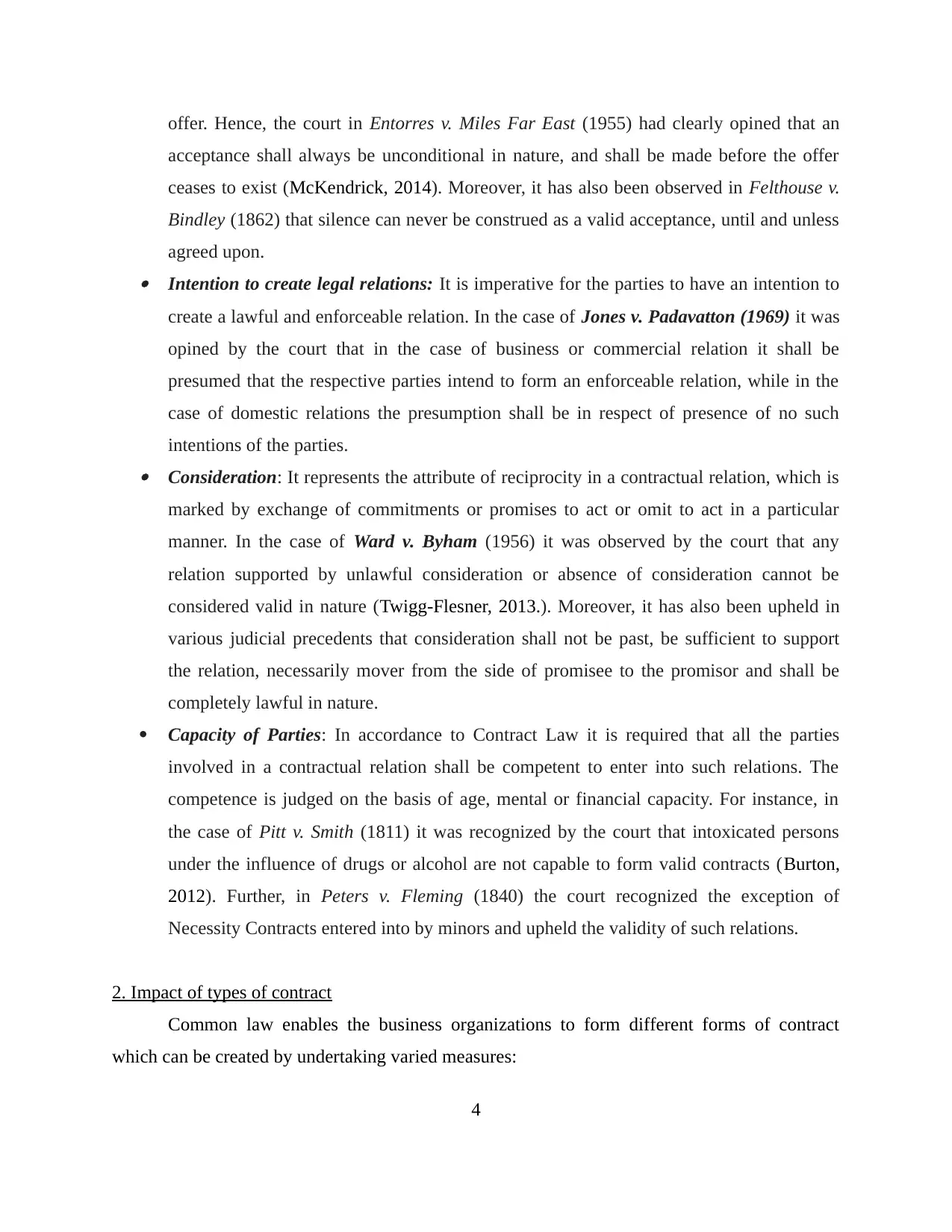
offer. Hence, the court in Entorres v. Miles Far East (1955) had clearly opined that an
acceptance shall always be unconditional in nature, and shall be made before the offer
ceases to exist (McKendrick, 2014). Moreover, it has also been observed in Felthouse v.
Bindley (1862) that silence can never be construed as a valid acceptance, until and unless
agreed upon. Intention to create legal relations: It is imperative for the parties to have an intention to
create a lawful and enforceable relation. In the case of Jones v. Padavatton (1969) it was
opined by the court that in the case of business or commercial relation it shall be
presumed that the respective parties intend to form an enforceable relation, while in the
case of domestic relations the presumption shall be in respect of presence of no such
intentions of the parties. Consideration: It represents the attribute of reciprocity in a contractual relation, which is
marked by exchange of commitments or promises to act or omit to act in a particular
manner. In the case of Ward v. Byham (1956) it was observed by the court that any
relation supported by unlawful consideration or absence of consideration cannot be
considered valid in nature (Twigg-Flesner, 2013.). Moreover, it has also been upheld in
various judicial precedents that consideration shall not be past, be sufficient to support
the relation, necessarily mover from the side of promisee to the promisor and shall be
completely lawful in nature.
Capacity of Parties: In accordance to Contract Law it is required that all the parties
involved in a contractual relation shall be competent to enter into such relations. The
competence is judged on the basis of age, mental or financial capacity. For instance, in
the case of Pitt v. Smith (1811) it was recognized by the court that intoxicated persons
under the influence of drugs or alcohol are not capable to form valid contracts (Burton,
2012). Further, in Peters v. Fleming (1840) the court recognized the exception of
Necessity Contracts entered into by minors and upheld the validity of such relations.
2. Impact of types of contract
Common law enables the business organizations to form different forms of contract
which can be created by undertaking varied measures:
4
acceptance shall always be unconditional in nature, and shall be made before the offer
ceases to exist (McKendrick, 2014). Moreover, it has also been observed in Felthouse v.
Bindley (1862) that silence can never be construed as a valid acceptance, until and unless
agreed upon. Intention to create legal relations: It is imperative for the parties to have an intention to
create a lawful and enforceable relation. In the case of Jones v. Padavatton (1969) it was
opined by the court that in the case of business or commercial relation it shall be
presumed that the respective parties intend to form an enforceable relation, while in the
case of domestic relations the presumption shall be in respect of presence of no such
intentions of the parties. Consideration: It represents the attribute of reciprocity in a contractual relation, which is
marked by exchange of commitments or promises to act or omit to act in a particular
manner. In the case of Ward v. Byham (1956) it was observed by the court that any
relation supported by unlawful consideration or absence of consideration cannot be
considered valid in nature (Twigg-Flesner, 2013.). Moreover, it has also been upheld in
various judicial precedents that consideration shall not be past, be sufficient to support
the relation, necessarily mover from the side of promisee to the promisor and shall be
completely lawful in nature.
Capacity of Parties: In accordance to Contract Law it is required that all the parties
involved in a contractual relation shall be competent to enter into such relations. The
competence is judged on the basis of age, mental or financial capacity. For instance, in
the case of Pitt v. Smith (1811) it was recognized by the court that intoxicated persons
under the influence of drugs or alcohol are not capable to form valid contracts (Burton,
2012). Further, in Peters v. Fleming (1840) the court recognized the exception of
Necessity Contracts entered into by minors and upheld the validity of such relations.
2. Impact of types of contract
Common law enables the business organizations to form different forms of contract
which can be created by undertaking varied measures:
4
Paraphrase This Document
Need a fresh take? Get an instant paraphrase of this document with our AI Paraphraser
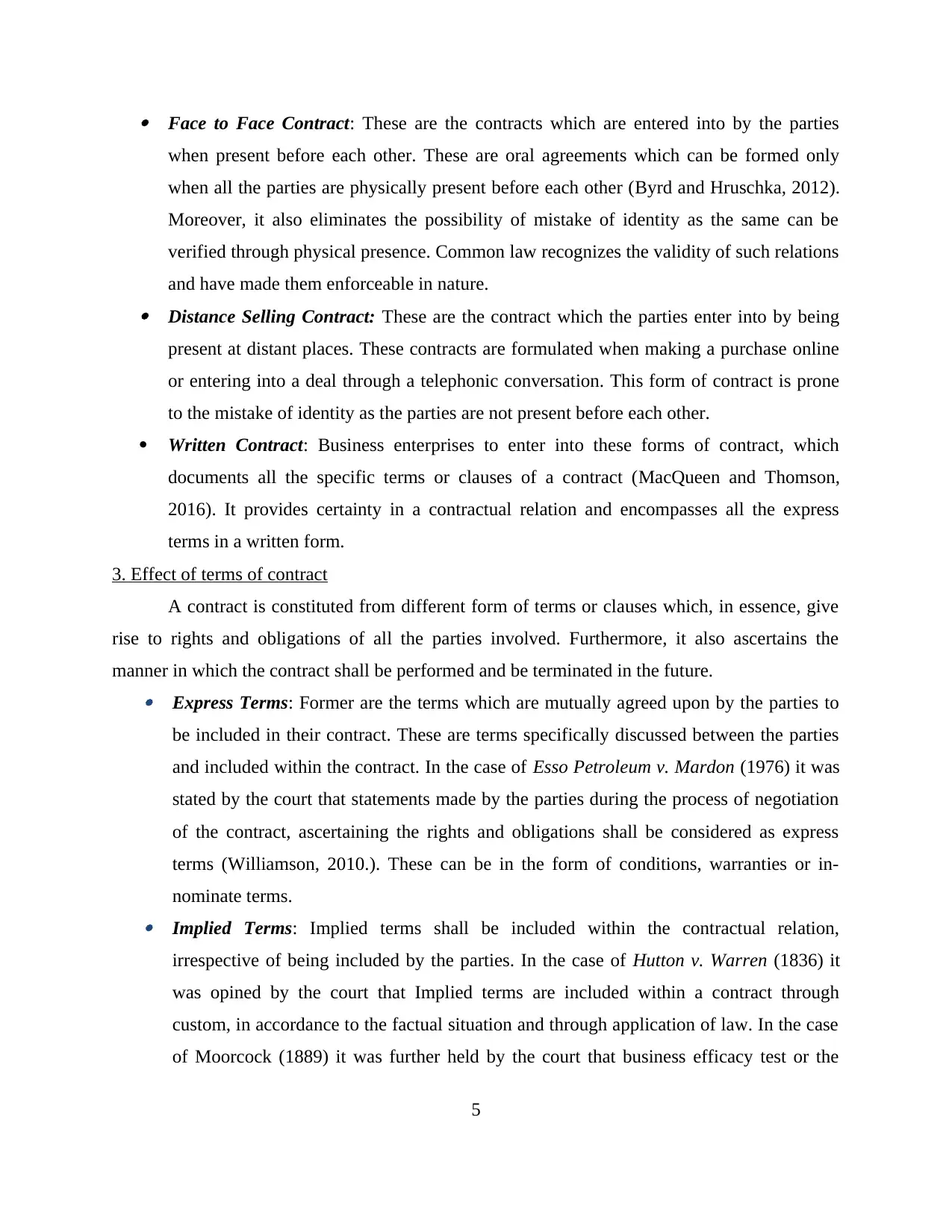
Face to Face Contract: These are the contracts which are entered into by the parties
when present before each other. These are oral agreements which can be formed only
when all the parties are physically present before each other (Byrd and Hruschka, 2012).
Moreover, it also eliminates the possibility of mistake of identity as the same can be
verified through physical presence. Common law recognizes the validity of such relations
and have made them enforceable in nature. Distance Selling Contract: These are the contract which the parties enter into by being
present at distant places. These contracts are formulated when making a purchase online
or entering into a deal through a telephonic conversation. This form of contract is prone
to the mistake of identity as the parties are not present before each other.
Written Contract: Business enterprises to enter into these forms of contract, which
documents all the specific terms or clauses of a contract (MacQueen and Thomson,
2016). It provides certainty in a contractual relation and encompasses all the express
terms in a written form.
3. Effect of terms of contract
A contract is constituted from different form of terms or clauses which, in essence, give
rise to rights and obligations of all the parties involved. Furthermore, it also ascertains the
manner in which the contract shall be performed and be terminated in the future. Express Terms: Former are the terms which are mutually agreed upon by the parties to
be included in their contract. These are terms specifically discussed between the parties
and included within the contract. In the case of Esso Petroleum v. Mardon (1976) it was
stated by the court that statements made by the parties during the process of negotiation
of the contract, ascertaining the rights and obligations shall be considered as express
terms (Williamson, 2010.). These can be in the form of conditions, warranties or in-
nominate terms. Implied Terms: Implied terms shall be included within the contractual relation,
irrespective of being included by the parties. In the case of Hutton v. Warren (1836) it
was opined by the court that Implied terms are included within a contract through
custom, in accordance to the factual situation and through application of law. In the case
of Moorcock (1889) it was further held by the court that business efficacy test or the
5
when present before each other. These are oral agreements which can be formed only
when all the parties are physically present before each other (Byrd and Hruschka, 2012).
Moreover, it also eliminates the possibility of mistake of identity as the same can be
verified through physical presence. Common law recognizes the validity of such relations
and have made them enforceable in nature. Distance Selling Contract: These are the contract which the parties enter into by being
present at distant places. These contracts are formulated when making a purchase online
or entering into a deal through a telephonic conversation. This form of contract is prone
to the mistake of identity as the parties are not present before each other.
Written Contract: Business enterprises to enter into these forms of contract, which
documents all the specific terms or clauses of a contract (MacQueen and Thomson,
2016). It provides certainty in a contractual relation and encompasses all the express
terms in a written form.
3. Effect of terms of contract
A contract is constituted from different form of terms or clauses which, in essence, give
rise to rights and obligations of all the parties involved. Furthermore, it also ascertains the
manner in which the contract shall be performed and be terminated in the future. Express Terms: Former are the terms which are mutually agreed upon by the parties to
be included in their contract. These are terms specifically discussed between the parties
and included within the contract. In the case of Esso Petroleum v. Mardon (1976) it was
stated by the court that statements made by the parties during the process of negotiation
of the contract, ascertaining the rights and obligations shall be considered as express
terms (Williamson, 2010.). These can be in the form of conditions, warranties or in-
nominate terms. Implied Terms: Implied terms shall be included within the contractual relation,
irrespective of being included by the parties. In the case of Hutton v. Warren (1836) it
was opined by the court that Implied terms are included within a contract through
custom, in accordance to the factual situation and through application of law. In the case
of Moorcock (1889) it was further held by the court that business efficacy test or the
5

officious bystander test can be applied to include a term in fact (Malhotra and Lumineau,
2011). In the case of Shirlaw v. Southern Foundries (1939) it was observed by the court
that implied terms are enforceable in court of law in the same manner as express terms.
Representations: These are the specific statements made by the parties, through words or
conduct, reflecting certain facts in order to induce others to form a contractual relation.
Hence, representations are reflection of the current status of subject matter or other
related aspects. Breach of the same shall make the parties liable.
TASK 2
4. Case Scenario
Ivan on visiting a bookshop, owned by Todor, sees one of the books displayed for sale. It
is tagged with a price of £50. Ivan decides to purchase the same book and proceed towards the
counter for payment. At that point in time he was informed that the book cannot be sold to him
as it was already sold to Carl and that no other copy is available.
In such factual scenario it is important to establish a clear distinction between an offer
and the concept of invitation to offer. The offer is communication of the intention to form a valid
contract to the other party. On the other hand the latter is merely a communication of an
invitation to make offers in respect to specific object. It is made to the public in general and not
to any specific person (Wang, Yeung and Zhang, 2011). In the case of Patridge v. Critenden
(1968) it was stated by the court that an offer can be accepted to form a valid contract, however,
an invitation to offer cannot be accepted and is not an essential element of contract. Further, in
the case of Fisher v. Bell (1961) it was opined by the court that goods kept for display in shops is
an invitation from the end of shopkeepers to make an offer and hence, the consumers cannot
accept the same (Svantesson and Clarke, 2010). In light of the same it can be concluded that
display of the HND book in Todor's bookstore amounted to an invitation to offer. Further, the
communication made by the Ivan to purchase the book was an offer, which was not accepted by
Todor. Hence, no contract could come into existence for lack of essential elements of contract.
5. Consequences of Classification of terms Condition: These are the essential terms of the contract and play an instrumental role in
fulfillment of the primary object of a contract. In the case of Poussard v. Spiers (1876) it
was opined by the court that the importance of these terms can be understood from the
6
2011). In the case of Shirlaw v. Southern Foundries (1939) it was observed by the court
that implied terms are enforceable in court of law in the same manner as express terms.
Representations: These are the specific statements made by the parties, through words or
conduct, reflecting certain facts in order to induce others to form a contractual relation.
Hence, representations are reflection of the current status of subject matter or other
related aspects. Breach of the same shall make the parties liable.
TASK 2
4. Case Scenario
Ivan on visiting a bookshop, owned by Todor, sees one of the books displayed for sale. It
is tagged with a price of £50. Ivan decides to purchase the same book and proceed towards the
counter for payment. At that point in time he was informed that the book cannot be sold to him
as it was already sold to Carl and that no other copy is available.
In such factual scenario it is important to establish a clear distinction between an offer
and the concept of invitation to offer. The offer is communication of the intention to form a valid
contract to the other party. On the other hand the latter is merely a communication of an
invitation to make offers in respect to specific object. It is made to the public in general and not
to any specific person (Wang, Yeung and Zhang, 2011). In the case of Patridge v. Critenden
(1968) it was stated by the court that an offer can be accepted to form a valid contract, however,
an invitation to offer cannot be accepted and is not an essential element of contract. Further, in
the case of Fisher v. Bell (1961) it was opined by the court that goods kept for display in shops is
an invitation from the end of shopkeepers to make an offer and hence, the consumers cannot
accept the same (Svantesson and Clarke, 2010). In light of the same it can be concluded that
display of the HND book in Todor's bookstore amounted to an invitation to offer. Further, the
communication made by the Ivan to purchase the book was an offer, which was not accepted by
Todor. Hence, no contract could come into existence for lack of essential elements of contract.
5. Consequences of Classification of terms Condition: These are the essential terms of the contract and play an instrumental role in
fulfillment of the primary object of a contract. In the case of Poussard v. Spiers (1876) it
was opined by the court that the importance of these terms can be understood from the
6
⊘ This is a preview!⊘
Do you want full access?
Subscribe today to unlock all pages.

Trusted by 1+ million students worldwide
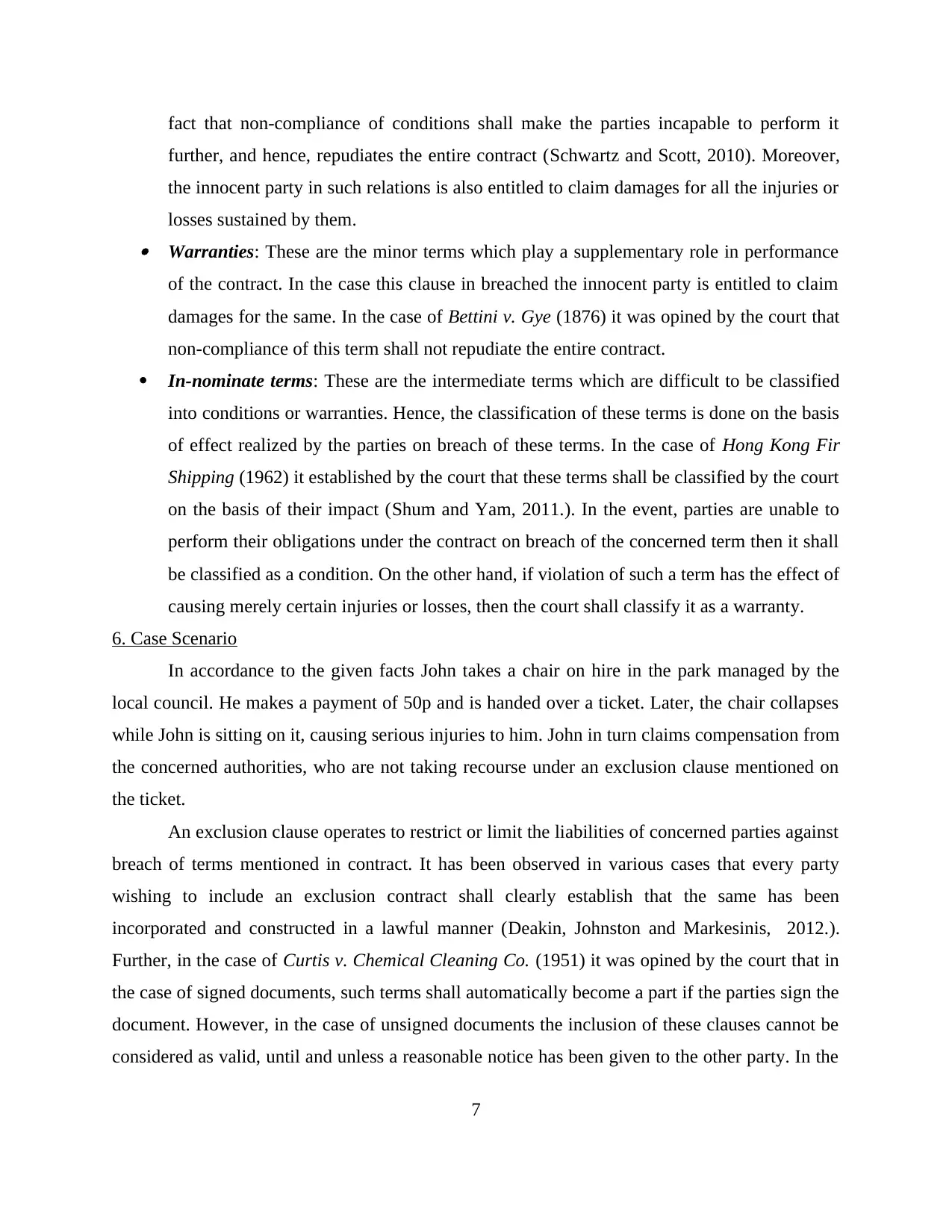
fact that non-compliance of conditions shall make the parties incapable to perform it
further, and hence, repudiates the entire contract (Schwartz and Scott, 2010). Moreover,
the innocent party in such relations is also entitled to claim damages for all the injuries or
losses sustained by them. Warranties: These are the minor terms which play a supplementary role in performance
of the contract. In the case this clause in breached the innocent party is entitled to claim
damages for the same. In the case of Bettini v. Gye (1876) it was opined by the court that
non-compliance of this term shall not repudiate the entire contract.
In-nominate terms: These are the intermediate terms which are difficult to be classified
into conditions or warranties. Hence, the classification of these terms is done on the basis
of effect realized by the parties on breach of these terms. In the case of Hong Kong Fir
Shipping (1962) it established by the court that these terms shall be classified by the court
on the basis of their impact (Shum and Yam, 2011.). In the event, parties are unable to
perform their obligations under the contract on breach of the concerned term then it shall
be classified as a condition. On the other hand, if violation of such a term has the effect of
causing merely certain injuries or losses, then the court shall classify it as a warranty.
6. Case Scenario
In accordance to the given facts John takes a chair on hire in the park managed by the
local council. He makes a payment of 50p and is handed over a ticket. Later, the chair collapses
while John is sitting on it, causing serious injuries to him. John in turn claims compensation from
the concerned authorities, who are not taking recourse under an exclusion clause mentioned on
the ticket.
An exclusion clause operates to restrict or limit the liabilities of concerned parties against
breach of terms mentioned in contract. It has been observed in various cases that every party
wishing to include an exclusion contract shall clearly establish that the same has been
incorporated and constructed in a lawful manner (Deakin, Johnston and Markesinis, 2012.).
Further, in the case of Curtis v. Chemical Cleaning Co. (1951) it was opined by the court that in
the case of signed documents, such terms shall automatically become a part if the parties sign the
document. However, in the case of unsigned documents the inclusion of these clauses cannot be
considered as valid, until and unless a reasonable notice has been given to the other party. In the
7
further, and hence, repudiates the entire contract (Schwartz and Scott, 2010). Moreover,
the innocent party in such relations is also entitled to claim damages for all the injuries or
losses sustained by them. Warranties: These are the minor terms which play a supplementary role in performance
of the contract. In the case this clause in breached the innocent party is entitled to claim
damages for the same. In the case of Bettini v. Gye (1876) it was opined by the court that
non-compliance of this term shall not repudiate the entire contract.
In-nominate terms: These are the intermediate terms which are difficult to be classified
into conditions or warranties. Hence, the classification of these terms is done on the basis
of effect realized by the parties on breach of these terms. In the case of Hong Kong Fir
Shipping (1962) it established by the court that these terms shall be classified by the court
on the basis of their impact (Shum and Yam, 2011.). In the event, parties are unable to
perform their obligations under the contract on breach of the concerned term then it shall
be classified as a condition. On the other hand, if violation of such a term has the effect of
causing merely certain injuries or losses, then the court shall classify it as a warranty.
6. Case Scenario
In accordance to the given facts John takes a chair on hire in the park managed by the
local council. He makes a payment of 50p and is handed over a ticket. Later, the chair collapses
while John is sitting on it, causing serious injuries to him. John in turn claims compensation from
the concerned authorities, who are not taking recourse under an exclusion clause mentioned on
the ticket.
An exclusion clause operates to restrict or limit the liabilities of concerned parties against
breach of terms mentioned in contract. It has been observed in various cases that every party
wishing to include an exclusion contract shall clearly establish that the same has been
incorporated and constructed in a lawful manner (Deakin, Johnston and Markesinis, 2012.).
Further, in the case of Curtis v. Chemical Cleaning Co. (1951) it was opined by the court that in
the case of signed documents, such terms shall automatically become a part if the parties sign the
document. However, in the case of unsigned documents the inclusion of these clauses cannot be
considered as valid, until and unless a reasonable notice has been given to the other party. In the
7
Paraphrase This Document
Need a fresh take? Get an instant paraphrase of this document with our AI Paraphraser
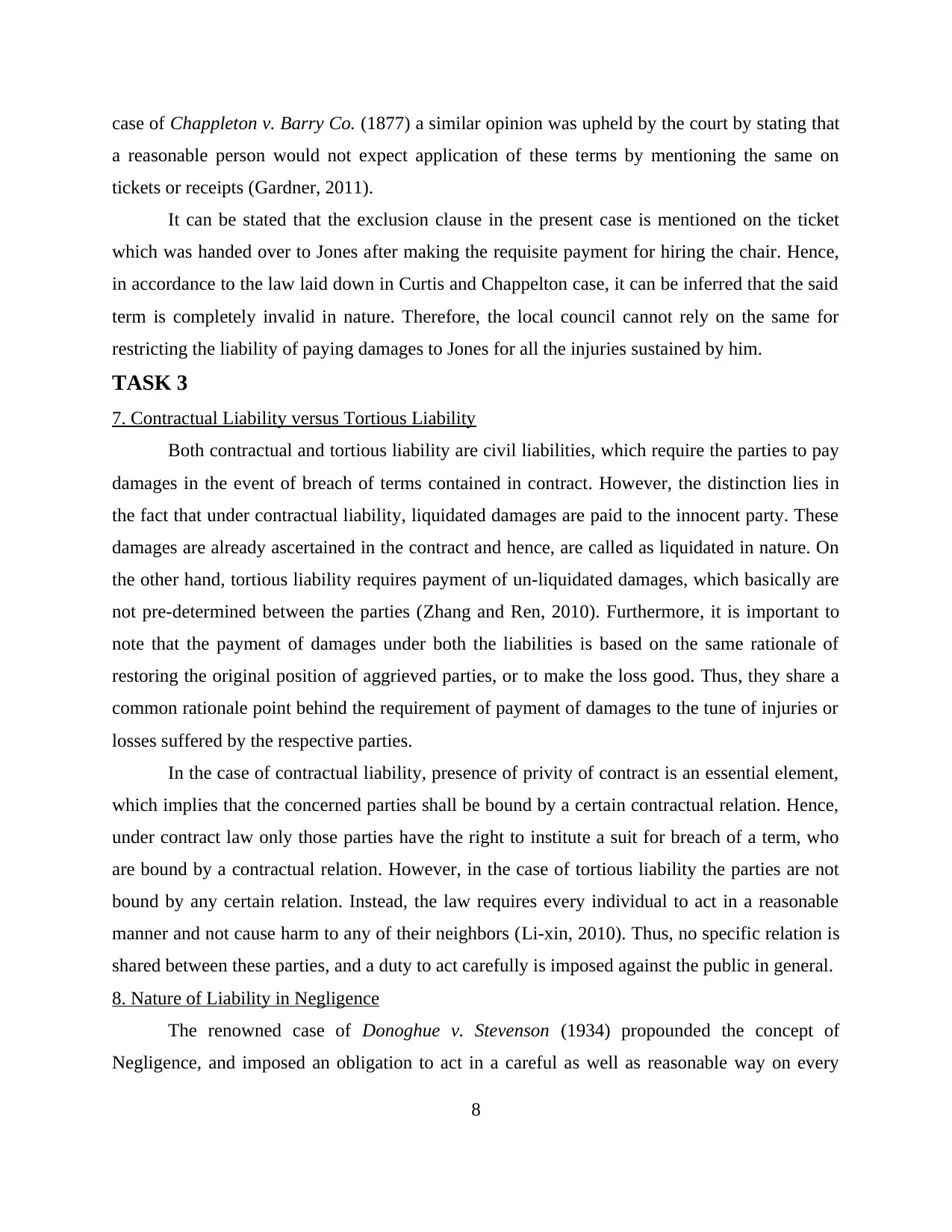
case of Chappleton v. Barry Co. (1877) a similar opinion was upheld by the court by stating that
a reasonable person would not expect application of these terms by mentioning the same on
tickets or receipts (Gardner, 2011).
It can be stated that the exclusion clause in the present case is mentioned on the ticket
which was handed over to Jones after making the requisite payment for hiring the chair. Hence,
in accordance to the law laid down in Curtis and Chappelton case, it can be inferred that the said
term is completely invalid in nature. Therefore, the local council cannot rely on the same for
restricting the liability of paying damages to Jones for all the injuries sustained by him.
TASK 3
7. Contractual Liability versus Tortious Liability
Both contractual and tortious liability are civil liabilities, which require the parties to pay
damages in the event of breach of terms contained in contract. However, the distinction lies in
the fact that under contractual liability, liquidated damages are paid to the innocent party. These
damages are already ascertained in the contract and hence, are called as liquidated in nature. On
the other hand, tortious liability requires payment of un-liquidated damages, which basically are
not pre-determined between the parties (Zhang and Ren, 2010). Furthermore, it is important to
note that the payment of damages under both the liabilities is based on the same rationale of
restoring the original position of aggrieved parties, or to make the loss good. Thus, they share a
common rationale point behind the requirement of payment of damages to the tune of injuries or
losses suffered by the respective parties.
In the case of contractual liability, presence of privity of contract is an essential element,
which implies that the concerned parties shall be bound by a certain contractual relation. Hence,
under contract law only those parties have the right to institute a suit for breach of a term, who
are bound by a contractual relation. However, in the case of tortious liability the parties are not
bound by any certain relation. Instead, the law requires every individual to act in a reasonable
manner and not cause harm to any of their neighbors (Li-xin, 2010). Thus, no specific relation is
shared between these parties, and a duty to act carefully is imposed against the public in general.
8. Nature of Liability in Negligence
The renowned case of Donoghue v. Stevenson (1934) propounded the concept of
Negligence, and imposed an obligation to act in a careful as well as reasonable way on every
8
a reasonable person would not expect application of these terms by mentioning the same on
tickets or receipts (Gardner, 2011).
It can be stated that the exclusion clause in the present case is mentioned on the ticket
which was handed over to Jones after making the requisite payment for hiring the chair. Hence,
in accordance to the law laid down in Curtis and Chappelton case, it can be inferred that the said
term is completely invalid in nature. Therefore, the local council cannot rely on the same for
restricting the liability of paying damages to Jones for all the injuries sustained by him.
TASK 3
7. Contractual Liability versus Tortious Liability
Both contractual and tortious liability are civil liabilities, which require the parties to pay
damages in the event of breach of terms contained in contract. However, the distinction lies in
the fact that under contractual liability, liquidated damages are paid to the innocent party. These
damages are already ascertained in the contract and hence, are called as liquidated in nature. On
the other hand, tortious liability requires payment of un-liquidated damages, which basically are
not pre-determined between the parties (Zhang and Ren, 2010). Furthermore, it is important to
note that the payment of damages under both the liabilities is based on the same rationale of
restoring the original position of aggrieved parties, or to make the loss good. Thus, they share a
common rationale point behind the requirement of payment of damages to the tune of injuries or
losses suffered by the respective parties.
In the case of contractual liability, presence of privity of contract is an essential element,
which implies that the concerned parties shall be bound by a certain contractual relation. Hence,
under contract law only those parties have the right to institute a suit for breach of a term, who
are bound by a contractual relation. However, in the case of tortious liability the parties are not
bound by any certain relation. Instead, the law requires every individual to act in a reasonable
manner and not cause harm to any of their neighbors (Li-xin, 2010). Thus, no specific relation is
shared between these parties, and a duty to act carefully is imposed against the public in general.
8. Nature of Liability in Negligence
The renowned case of Donoghue v. Stevenson (1934) propounded the concept of
Negligence, and imposed an obligation to act in a careful as well as reasonable way on every
8

individual of the society. In the case a person does not abide by the same and causes harm to
another person, he/she shall be liable under the Principle of Negligence. The court also
established the following elements of negligence to constitute the tort of negligence in the court
of law: Duty of care: The defendant shall be imposed with a specific duty to act or omit to act in
a particular manner (Baumann and Heine, 2013). For instance every person driving a car
is imposed with a duty to drive carefully and not be intoxicated. Breach of Duty: The defendant shall further have acted in violation of the duty of care.
For instance, the driver drives the car under the influence of alcohol. Damage/ Causation: The breach of duty by the defendant shall have caused injury to the
plaintiff or claimant. A direct nexus between the two shall be established.
Remoteness: Lastly, it shall be established that the consequence of breach of duty was
foreseeable in nature, and the defendant could have easily foreseen if acted reasonably.
In the event all these elements are proved before the court of law, the principle of
negligence shall make the defendant liable jointly or severally, vicariously or for contributory
negligence.
9. Vicarious Liability
The doctrine of vicarious liability is specifically highly vital for business enterprises. This
is a concept which is applicable on relations which are in the nature of principal-agent. Hence, in
such relations the principal is made liable for the negligent actions of the agent. The purpose of
law behind imposing such a liability is that agent in essence is acting on behalf of the principal
and is undertaking his work (Deakin, Johnston and Markesinis, 2012.). This infers that all the
benefits shall be enjoyed by the principal and hence, other liabilities shall also be imposed on
him. In the case of business organizations maximum application is found on employer –
employee relation. In pursuance to the same every action undertaken by an employee within the
course of employment has the capacity to vicariously make the employee liable. In the case of
Lister v. Hesley (2006) it was opined by the court that all the negligent actions of employee
which has caused harm to another person shall make the employer vicariously liable for payment
of damages. Further, it was also observed that the said action can be unauthorized or unethical in
nature, and this shall not hamper the liability imposed on the employer. However, it shall
9
another person, he/she shall be liable under the Principle of Negligence. The court also
established the following elements of negligence to constitute the tort of negligence in the court
of law: Duty of care: The defendant shall be imposed with a specific duty to act or omit to act in
a particular manner (Baumann and Heine, 2013). For instance every person driving a car
is imposed with a duty to drive carefully and not be intoxicated. Breach of Duty: The defendant shall further have acted in violation of the duty of care.
For instance, the driver drives the car under the influence of alcohol. Damage/ Causation: The breach of duty by the defendant shall have caused injury to the
plaintiff or claimant. A direct nexus between the two shall be established.
Remoteness: Lastly, it shall be established that the consequence of breach of duty was
foreseeable in nature, and the defendant could have easily foreseen if acted reasonably.
In the event all these elements are proved before the court of law, the principle of
negligence shall make the defendant liable jointly or severally, vicariously or for contributory
negligence.
9. Vicarious Liability
The doctrine of vicarious liability is specifically highly vital for business enterprises. This
is a concept which is applicable on relations which are in the nature of principal-agent. Hence, in
such relations the principal is made liable for the negligent actions of the agent. The purpose of
law behind imposing such a liability is that agent in essence is acting on behalf of the principal
and is undertaking his work (Deakin, Johnston and Markesinis, 2012.). This infers that all the
benefits shall be enjoyed by the principal and hence, other liabilities shall also be imposed on
him. In the case of business organizations maximum application is found on employer –
employee relation. In pursuance to the same every action undertaken by an employee within the
course of employment has the capacity to vicariously make the employee liable. In the case of
Lister v. Hesley (2006) it was opined by the court that all the negligent actions of employee
which has caused harm to another person shall make the employer vicariously liable for payment
of damages. Further, it was also observed that the said action can be unauthorized or unethical in
nature, and this shall not hamper the liability imposed on the employer. However, it shall
9
⊘ This is a preview!⊘
Do you want full access?
Subscribe today to unlock all pages.

Trusted by 1+ million students worldwide

essentially be within the course of employment (Wang, Yeung and Zhang, 2011). Moreover, in
the case of Performing Right Society Ltd. v Mitchell and Booker Ltd. (1924) it was held by the
court that in order to apply the doctrine of vicarious liability it is necessary for presence of
contract of service. In order to assure the same it shall be proved that the employer exercises
control and supervision over the work being carried out by the employee. Moreover, it shall also
be established that the right of suspension is held by the employer.
10. Case Scenario
In accordance to the given factual scenario it is clear that David is over speeding his car
and in the process collides with a telephone pole while saving a child Kevin. However, the
collision easily breaks the pole into two parts and injures Kevin.
David was under a duty of care to drive within the speed limit, which is beached by him.
Due to this breach of the duty damage is caused to the telephonic pole, which subsequently
causes harm to Kevin. However, there is no direct nexus between the breach of duty and damage
sustained by Kevin. However, it is important to note that breach of duty led to snapping of the
telephone pole. Moreover, it is also important to note that the pole easily broke down, which
implied that the telephone company was negligent to use inappropriate material for erection of
the same. They could have easily foreseen such situations and hence, should have used strong
materials for manufacturing the poles and placing them on the roads.
Thus, in such circumstances, it can be stated that this is a case of contributory negligence as both
David and the telephone company acted in breach of duty and caused injuries to Kevin.
11. Case scenario
As stated in facts Colin, the head Chef of Regent Hotel, knocks on the head of Roger, the
dishwasher. Severe injuries are sustained by him, however he refuses to go to the hospital. Later,
Roger decides to claim damages for the injuries sustained by him.
In the present case at the foremost instance it is important to ascertain the kind
employment relation shared between the head Chef and the management of Regent Hotel. If it
can be established that a contract of service exists between the two, doctrine of vicarious liability
can be applied. Thus, the negligent action of Colin can be said to be undertaken within the course
of employment, however, is unauthorized in nature. In light of the law followed in the case of
Lister v. Hesley (2006) it can be stated that the Regent Hotel can be made vicariously liable for
10
the case of Performing Right Society Ltd. v Mitchell and Booker Ltd. (1924) it was held by the
court that in order to apply the doctrine of vicarious liability it is necessary for presence of
contract of service. In order to assure the same it shall be proved that the employer exercises
control and supervision over the work being carried out by the employee. Moreover, it shall also
be established that the right of suspension is held by the employer.
10. Case Scenario
In accordance to the given factual scenario it is clear that David is over speeding his car
and in the process collides with a telephone pole while saving a child Kevin. However, the
collision easily breaks the pole into two parts and injures Kevin.
David was under a duty of care to drive within the speed limit, which is beached by him.
Due to this breach of the duty damage is caused to the telephonic pole, which subsequently
causes harm to Kevin. However, there is no direct nexus between the breach of duty and damage
sustained by Kevin. However, it is important to note that breach of duty led to snapping of the
telephone pole. Moreover, it is also important to note that the pole easily broke down, which
implied that the telephone company was negligent to use inappropriate material for erection of
the same. They could have easily foreseen such situations and hence, should have used strong
materials for manufacturing the poles and placing them on the roads.
Thus, in such circumstances, it can be stated that this is a case of contributory negligence as both
David and the telephone company acted in breach of duty and caused injuries to Kevin.
11. Case scenario
As stated in facts Colin, the head Chef of Regent Hotel, knocks on the head of Roger, the
dishwasher. Severe injuries are sustained by him, however he refuses to go to the hospital. Later,
Roger decides to claim damages for the injuries sustained by him.
In the present case at the foremost instance it is important to ascertain the kind
employment relation shared between the head Chef and the management of Regent Hotel. If it
can be established that a contract of service exists between the two, doctrine of vicarious liability
can be applied. Thus, the negligent action of Colin can be said to be undertaken within the course
of employment, however, is unauthorized in nature. In light of the law followed in the case of
Lister v. Hesley (2006) it can be stated that the Regent Hotel can be made vicariously liable for
10
Paraphrase This Document
Need a fresh take? Get an instant paraphrase of this document with our AI Paraphraser
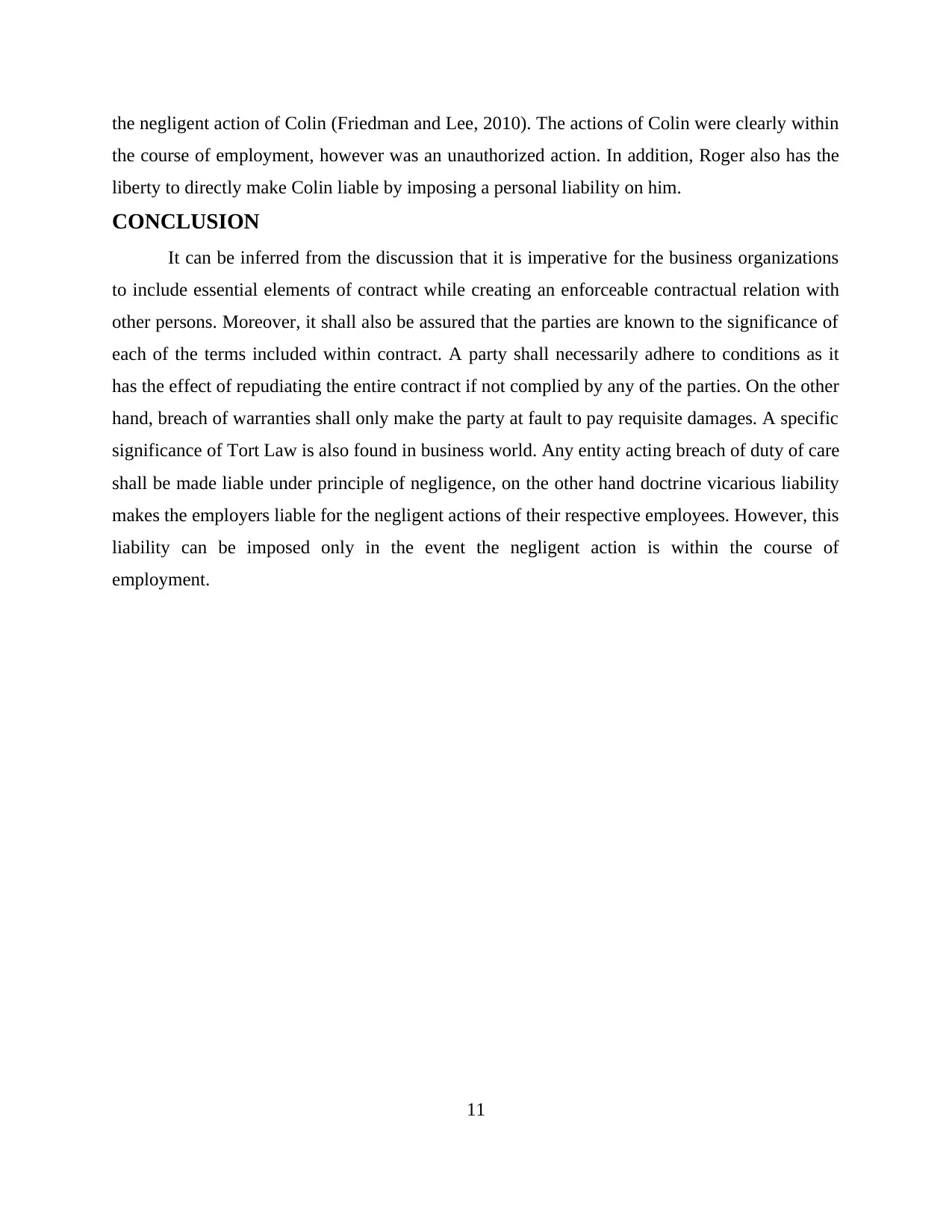
the negligent action of Colin (Friedman and Lee, 2010). The actions of Colin were clearly within
the course of employment, however was an unauthorized action. In addition, Roger also has the
liberty to directly make Colin liable by imposing a personal liability on him.
CONCLUSION
It can be inferred from the discussion that it is imperative for the business organizations
to include essential elements of contract while creating an enforceable contractual relation with
other persons. Moreover, it shall also be assured that the parties are known to the significance of
each of the terms included within contract. A party shall necessarily adhere to conditions as it
has the effect of repudiating the entire contract if not complied by any of the parties. On the other
hand, breach of warranties shall only make the party at fault to pay requisite damages. A specific
significance of Tort Law is also found in business world. Any entity acting breach of duty of care
shall be made liable under principle of negligence, on the other hand doctrine vicarious liability
makes the employers liable for the negligent actions of their respective employees. However, this
liability can be imposed only in the event the negligent action is within the course of
employment.
11
the course of employment, however was an unauthorized action. In addition, Roger also has the
liberty to directly make Colin liable by imposing a personal liability on him.
CONCLUSION
It can be inferred from the discussion that it is imperative for the business organizations
to include essential elements of contract while creating an enforceable contractual relation with
other persons. Moreover, it shall also be assured that the parties are known to the significance of
each of the terms included within contract. A party shall necessarily adhere to conditions as it
has the effect of repudiating the entire contract if not complied by any of the parties. On the other
hand, breach of warranties shall only make the party at fault to pay requisite damages. A specific
significance of Tort Law is also found in business world. Any entity acting breach of duty of care
shall be made liable under principle of negligence, on the other hand doctrine vicarious liability
makes the employers liable for the negligent actions of their respective employees. However, this
liability can be imposed only in the event the negligent action is within the course of
employment.
11
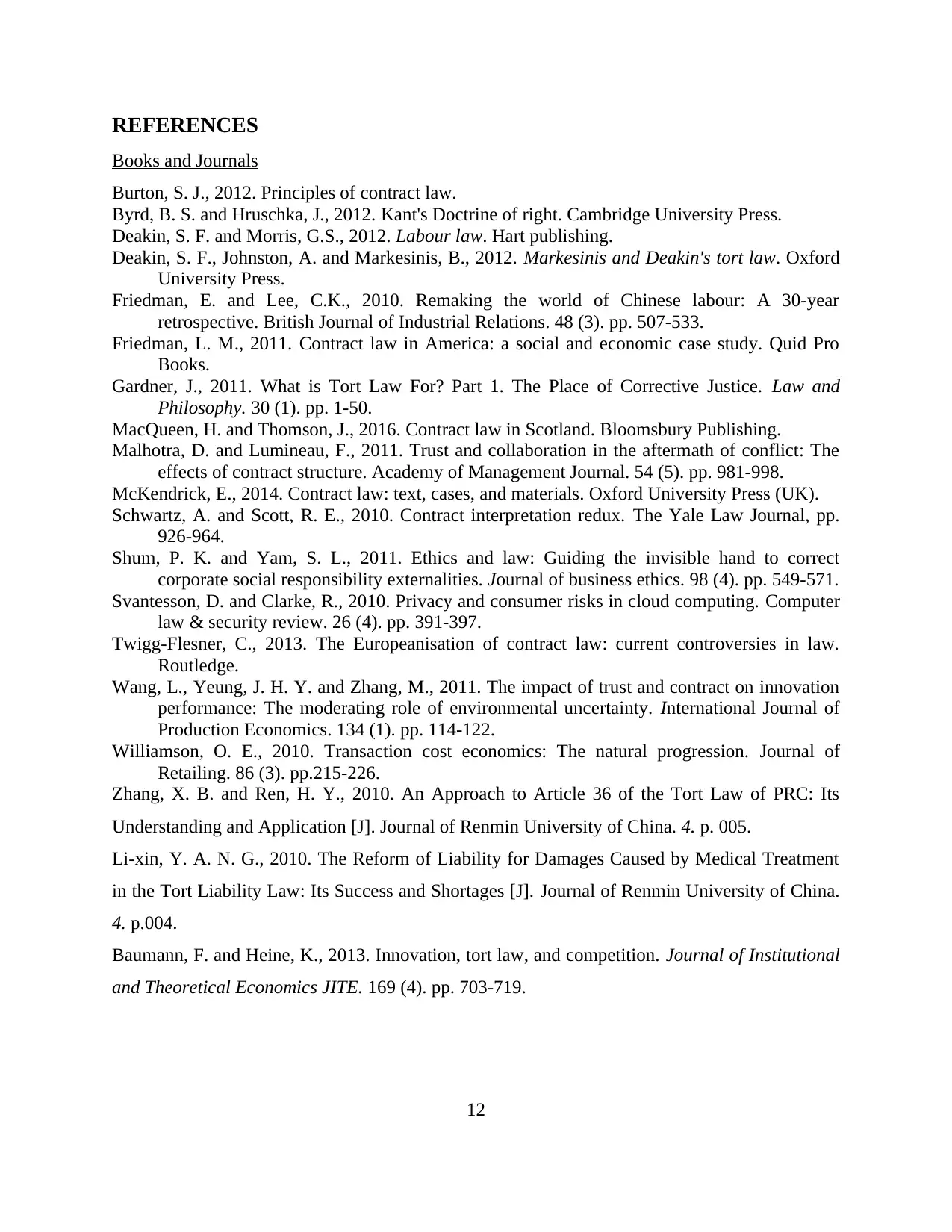
REFERENCES
Books and Journals
Burton, S. J., 2012. Principles of contract law.
Byrd, B. S. and Hruschka, J., 2012. Kant's Doctrine of right. Cambridge University Press.
Deakin, S. F. and Morris, G.S., 2012. Labour law. Hart publishing.
Deakin, S. F., Johnston, A. and Markesinis, B., 2012. Markesinis and Deakin's tort law. Oxford
University Press.
Friedman, E. and Lee, C.K., 2010. Remaking the world of Chinese labour: A 30‐year
retrospective. British Journal of Industrial Relations. 48 (3). pp. 507-533.
Friedman, L. M., 2011. Contract law in America: a social and economic case study. Quid Pro
Books.
Gardner, J., 2011. What is Tort Law For? Part 1. The Place of Corrective Justice. Law and
Philosophy. 30 (1). pp. 1-50.
MacQueen, H. and Thomson, J., 2016. Contract law in Scotland. Bloomsbury Publishing.
Malhotra, D. and Lumineau, F., 2011. Trust and collaboration in the aftermath of conflict: The
effects of contract structure. Academy of Management Journal. 54 (5). pp. 981-998.
McKendrick, E., 2014. Contract law: text, cases, and materials. Oxford University Press (UK).
Schwartz, A. and Scott, R. E., 2010. Contract interpretation redux. The Yale Law Journal, pp.
926-964.
Shum, P. K. and Yam, S. L., 2011. Ethics and law: Guiding the invisible hand to correct
corporate social responsibility externalities. Journal of business ethics. 98 (4). pp. 549-571.
Svantesson, D. and Clarke, R., 2010. Privacy and consumer risks in cloud computing. Computer
law & security review. 26 (4). pp. 391-397.
Twigg-Flesner, C., 2013. The Europeanisation of contract law: current controversies in law.
Routledge.
Wang, L., Yeung, J. H. Y. and Zhang, M., 2011. The impact of trust and contract on innovation
performance: The moderating role of environmental uncertainty. International Journal of
Production Economics. 134 (1). pp. 114-122.
Williamson, O. E., 2010. Transaction cost economics: The natural progression. Journal of
Retailing. 86 (3). pp.215-226.
Zhang, X. B. and Ren, H. Y., 2010. An Approach to Article 36 of the Tort Law of PRC: Its
Understanding and Application [J]. Journal of Renmin University of China. 4. p. 005.
Li-xin, Y. A. N. G., 2010. The Reform of Liability for Damages Caused by Medical Treatment
in the Tort Liability Law: Its Success and Shortages [J]. Journal of Renmin University of China.
4. p.004.
Baumann, F. and Heine, K., 2013. Innovation, tort law, and competition. Journal of Institutional
and Theoretical Economics JITE. 169 (4). pp. 703-719.
12
Books and Journals
Burton, S. J., 2012. Principles of contract law.
Byrd, B. S. and Hruschka, J., 2012. Kant's Doctrine of right. Cambridge University Press.
Deakin, S. F. and Morris, G.S., 2012. Labour law. Hart publishing.
Deakin, S. F., Johnston, A. and Markesinis, B., 2012. Markesinis and Deakin's tort law. Oxford
University Press.
Friedman, E. and Lee, C.K., 2010. Remaking the world of Chinese labour: A 30‐year
retrospective. British Journal of Industrial Relations. 48 (3). pp. 507-533.
Friedman, L. M., 2011. Contract law in America: a social and economic case study. Quid Pro
Books.
Gardner, J., 2011. What is Tort Law For? Part 1. The Place of Corrective Justice. Law and
Philosophy. 30 (1). pp. 1-50.
MacQueen, H. and Thomson, J., 2016. Contract law in Scotland. Bloomsbury Publishing.
Malhotra, D. and Lumineau, F., 2011. Trust and collaboration in the aftermath of conflict: The
effects of contract structure. Academy of Management Journal. 54 (5). pp. 981-998.
McKendrick, E., 2014. Contract law: text, cases, and materials. Oxford University Press (UK).
Schwartz, A. and Scott, R. E., 2010. Contract interpretation redux. The Yale Law Journal, pp.
926-964.
Shum, P. K. and Yam, S. L., 2011. Ethics and law: Guiding the invisible hand to correct
corporate social responsibility externalities. Journal of business ethics. 98 (4). pp. 549-571.
Svantesson, D. and Clarke, R., 2010. Privacy and consumer risks in cloud computing. Computer
law & security review. 26 (4). pp. 391-397.
Twigg-Flesner, C., 2013. The Europeanisation of contract law: current controversies in law.
Routledge.
Wang, L., Yeung, J. H. Y. and Zhang, M., 2011. The impact of trust and contract on innovation
performance: The moderating role of environmental uncertainty. International Journal of
Production Economics. 134 (1). pp. 114-122.
Williamson, O. E., 2010. Transaction cost economics: The natural progression. Journal of
Retailing. 86 (3). pp.215-226.
Zhang, X. B. and Ren, H. Y., 2010. An Approach to Article 36 of the Tort Law of PRC: Its
Understanding and Application [J]. Journal of Renmin University of China. 4. p. 005.
Li-xin, Y. A. N. G., 2010. The Reform of Liability for Damages Caused by Medical Treatment
in the Tort Liability Law: Its Success and Shortages [J]. Journal of Renmin University of China.
4. p.004.
Baumann, F. and Heine, K., 2013. Innovation, tort law, and competition. Journal of Institutional
and Theoretical Economics JITE. 169 (4). pp. 703-719.
12
⊘ This is a preview!⊘
Do you want full access?
Subscribe today to unlock all pages.

Trusted by 1+ million students worldwide
1 out of 12
Related Documents
Your All-in-One AI-Powered Toolkit for Academic Success.
+13062052269
info@desklib.com
Available 24*7 on WhatsApp / Email
![[object Object]](/_next/static/media/star-bottom.7253800d.svg)
Unlock your academic potential
Copyright © 2020–2025 A2Z Services. All Rights Reserved. Developed and managed by ZUCOL.





